
Training Using Specific Foot Sessions
It's all in the Footwork
Sun, Sep 22, 2002 - By Mike Muha
“Even if you only do some of these five minutes a week, they’ll make a big difference in you’re skiing.” J.D. Downing, coach at the 2002 NordicSkiRacer.com Fall Dryland Race Camp.
Specific foot exercises are extremely versatile, for all Nordic skiers, racers and tourers alike. You can keep a session very short and easy, or long and hard. You can focus on technique, strength, or aerobic capacity:
- Do them a repeats on the flats or an easy hill, and you can successfully combine people of all athletic abilities.
- Do a quick and easy 5-minute technique session when you’re out mowing your lawn.
- Use them as a warm up or warm down to a distance or interval session.
- Throw them into your distance run on the uphills.
- Use them as an interval session.
- Use them for explosive strength training.
O.K., so they’re useful. So what are they?
Simply put, specific foot drills replicate ski motions on foot. There are a zillion variations. Let’s break’em down into categories:
Step Holds
Step Hold are easy drills that teach technique and balance. One foot is always on the ground and you can keep your heart rate way down. Get into a skier’s ready position, step on to the glide leg, and hold. Step on to the other glide leg, and hold. You get the idea. Here are some variations:
- Step holds with arms behind the back.
- Skate step holds with V1 poling.
- Skate step holds with Alternate-V2 poling.
- Skate step holds with V2 poling.
- Diagonal stride step holds
- Doublepole with kick step holds.
- Step holds on flats, step holds on hills.
- Longer “holds” and shorter “holds”.
|
Skate Step-Hold with Alternate-V2 Poling Motion |
||
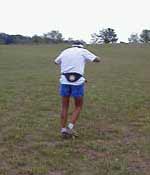 |
 |
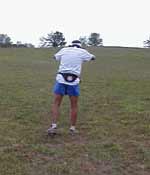 |
| Hold... (Right foot not touching the ground) |
...Step... (One foot always on the ground) |
...Hold (Left foot not touching the ground) |
You can do these anywhere, in any terrain, with anyone.
Kick Holds
Kick holds are step holds with airtime; both feet leave the ground. Kick to the glide foot, hold. Kick to the other glide foot, hold. Kick holds are the start of ‘ballistic” drills – drills that incorporate more explosive actions. Kick holds have all the same variations as step holds. Kicks holds require more force, so they help you develop more strength. Because of the airtime, they force you to develop better balance to nail the landing.
Step and Kick Hold Technique Tips
While we were practicing step and kick holds at the Dryland Camp, J.D. forced us to focus on proper technique – what you practice is how you’ll ski. The tips below apply equally to both skate and classic drills:
 |
|
Jeff, Matt, and Ann practice kick holds with hands behind the back. |
- Bend at the ankle.
- Grab the cookie: Reach you hands forward as if you were reaching for a cookie. This has the tendency to pull (drive) your hips forward (good) so you’re not stuck in the dreaded toilet position (bad). Forward-hips lets you fall onto your poles for greater poling power.
- Make sure you can see over your hands – your hands should not block your view forward.
- Keep the shoulders loose!
- When you step/kick onto the glide foot, put all your weight on that foot. The other foot should not be touching the ground - this is a balance drill, so learn to balance!
No need to do these drills to death when you practice them; five or ten minutes is fine. And no need for poles – they’re more likely to get in the way.
Ski Walking
Take step holds, get rid of the holds, and you have ski walking. Everything else – the variations, the technique – stays the same. If you have a good uphill – steeper is better – you can add poles. (If you add poles, focus an the pole push completion, not the initiation. That means planting the pole much further back than on skis).
Ski walking is great to add into a run; ski walk the uphills. Control heart rate by controlling tempo and steepness of hill (faster and steeper are harder). Out west in the mountains and at attitude, skiers can do distance or interval sessions over long, steep uphills, doing ski walking with poles. In Michigan, it’s much more difficult to get your heart rate up ski walking. Unless you have a nice long hill, J.D. suggests leaving your poles at home.
|
J.D. Ski Walks up an Easy Hill |
|||
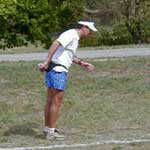 |
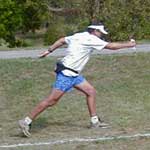 |
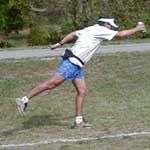 |
 |
Moosehufs
Moosehufs are kick holds, without the holds. Moosehufs are done on uphills.
I’ve incorporated moosehufs into several sessions this year. First, I'll do a few easy moosehufs up a short hill during a distance run, making sure to keep my heart rate low. I’ve also done short repeats (45 seconds to a minute) up the toboggan hill at higher heart rates. And I just finished a mousehuf interval session up a longish hill at Kensington Metropark: a 1-2-3 minute moosehuf ladder at below race heart rate; then another 1-2-3 ladder at race pace, finishing the last interval at above race pace heart rate. (And that last interval session was HARD – I could feel the lactate acid in my legs, and I had to repeat the mantra, “Grab the cookie, grab the cookie” to keep my arms going).
As you can see, you can vary the speed and distance of the moosehuf and the steepness of the terrain in order to maintain a particular target heart rate. Throw in 5 seconds during a run, do some short intervals, or go out and kill your self on multi-minute intervals if you have a long enough hill. You can also do moosehufs as strength: do short repeats up a hill. This is another great group drill.
Ski Bounding
Think of ski bounding as extreme moosehufs. Lots of airtime. Leaping over buildings in a single bound… Ski bounding is best for strength and short intervals, depending on the size of the hill and turnover speed.
